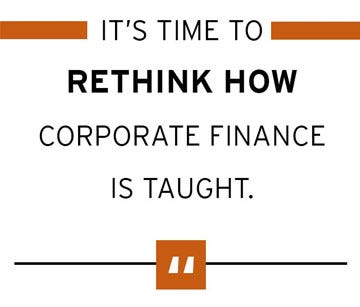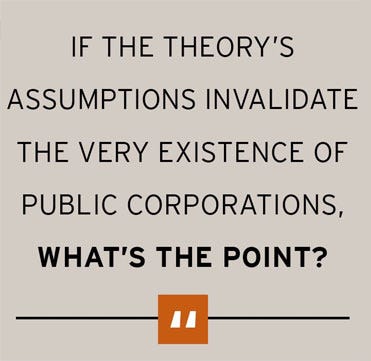Fixing Finance’s Embarrassing Paradox
Why it’s time to rethink how corporate finance is taught, according to a business school professor
By Adrienne Dawson

A challenge to a Nobel Prize-winning theory has a good chance of upending how finance is taught in college. Some would argue the challenge is long overdue, while others would prefer not to acknowledge it at all. But for Professor Ramesh Rao at the McCombs School of Business, it’s an opportunity to correct an embarrassing paradox.
In June of 1958, economists Franco Modigliani and Merton Miller published “The Cost of Capital, Corporate Finance, and the Theory of Investment” in the American Economic Review. It was a game-changing theory that said a company’s value is independent of its capital structure.
It all takes place in what’s known as a “frictionless” economy — a theoretical marketplace where things like taxes and bankruptcy don’t exist. In this economy, each individual is a stock and bondholder, and all wealth is created solely by trading securities. There is no need for cash.
Moreover, because there’s no need for it, the amount of cash a company has on its balance sheet is irrelevant, and financing — whether using cash, equity, or debt — has no effect on a company’s overall value. “If you take money out of your left pocket and put it in your right pocket,” Miller once said, “you are no richer.”
But there’s a catch: in their securities-based economy, companies don’t issue stocks; the stocks simply exist. And that, insists Rao, is a problem.
“The theory is mathematically elegant, absolutely beautiful,” he says, “but it contains a logical inconsistency.”

And that inconsistency is this: If securities exist, then public corporations must exist to issue them in the first place. But if everyone already has securities, then what’s the function of a company?
“If the theory’s assumptions invalidate the very existence of public corporations, what’s the point?” he asks. “And yet every modern corporate finance textbook is built around the Modigliani-Miller theorem. It influences corporate directors, bankruptcy courts, regulators, Wall Street executives. They all rely on the theorem’s implications to make decisions.”
He calls this the theory’s embarrassing paradox, and he set out to correct it.
It’s something that, until now, had never been done.
“This Is the Core of the Paper’s Results”
Rao begins with the concept of a primitive economy, one without firms or securities. In order to make money in this economy, an entrepreneur must first buy or rent equipment, obtain materials, and hire labor. To do this, the entrepreneur enters into nontraded contracts with workers, suppliers, and equipment leasing companies, promising to pay them after delivery of the goods or services. In doing so, however, the entrepreneur incurs a “non-tradability premium”: an additional cost that suppliers charge to compensate for the fact that these contracts can’t be immediately liquidated.
“This is the core of the paper’s results,” Rao stresses. “Securities are financial contracts that are traded daily in the stock and bond exchanges, and they can be converted to cash at any time. But suppliers don’t have that luxury. They can’t just liquidate their contracts and immediately get paid. So, they build this premium into the price of the goods and services they provide.”
The entrepreneur’s goal, however, is to minimize cost and maximize value, so the first objective is to reduce that non-tradability premium as much as possible. After all, it’s an added expense. He finds that the optimal way to do that is for the entrepreneur to hold cash on the company’s balance sheet. Having cash minimizes a supplier’s risk, which, in turn, enables the entrepreneur to negotiate a better price for equipment and materials.
But, what if the entrepreneur doesn’t have the necessary cash?
The best choice, Rao finds, is for the entrepreneur to establish a public corporation, issue securities on Wall Street, and hold that cash on the firm’s balance sheet.
But why?
Because it’s cheaper, he shows, than borrowing from a bank or creating a private company. Investors don’t charge non-tradability premiums for their cash. By forming a public company, the entrepreneur can put more cash on the balance sheet and, therefore, negotiate better prices for equipment and materials.
“Internal Financing Does Matter”
This is crucial, says Rao, because at this point, the entrepreneur’s firm becomes an intermediary between Wall Street’s investors and Main Street’s suppliers, bridging the economy’s financial and real sectors while minimizing the cost of doing business.
“If you can minimize cost, you can generate more cash flows.”—Ramesh Rao
“You’re going to create a higher stock price. Which means what? That corporation is creating more wealth for society: It’s creating more money in retirement accounts for firefighters and teachers, for workers holding 401(k)s and IRAs, and so on. Everybody benefits,” explains Rao.

More important, Rao’s findings show that this only works as long as the firm holds cash, which brings his research back to Modigliani and Miller’s initial assertion that financing decisions are irrelevant.
“Internal financing does matter,” writes Rao, because cash affects operating costs and, therefore, an investment’s net present value. “The irrelevance of working capital and firms no longer holds.”
“It’s Time to Rethink How Corporate Finance Is Taught”
But does it really matter what a theory says, even if it won a Nobel Prize?
Yes, Rao says, it does. “Corporate finance and investment theories show us how to calculate value, how to analyze companies’ financial strength, and they tell executives how to better manage their firms. But you’re not going to do that correctly if you follow a corporate finance theory that only holds in a world where corporations have no reason to exist.”
One take-away for other researchers and policy-makers is that Wall Street can be socially beneficial, he says. He acknowledges Wall Street’s notorious reputation for excess and abuses of power but insists it can also do good: Wall Street provides firms with cash, which increases a company’s cash flows and, ultimately, society’s wealth. That’s why he urges investors and analysts to focus not only on corporate earnings but also on changes in cash on a firm’s balance sheet. “Stockholders’ returns depend on corporate cash holdings,” he insists.
Business schools, however, have long-treated the question of working capital management as an afterthought in core finance courses. So when you shift the foundation of modern finance research, what does it mean for every business student whose first finance course begins with Modigliani and Miller’s cashless model?
“It means it’s time to rethink how corporate finance is taught,” says Rao.
“The Public Corporation as an Intermediary Between “Main Street” and Wall Street” was published in the Journal of Corporate Finance.
About this Post
Share:


